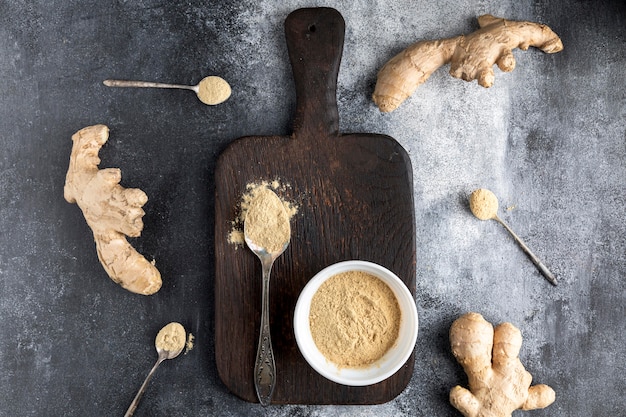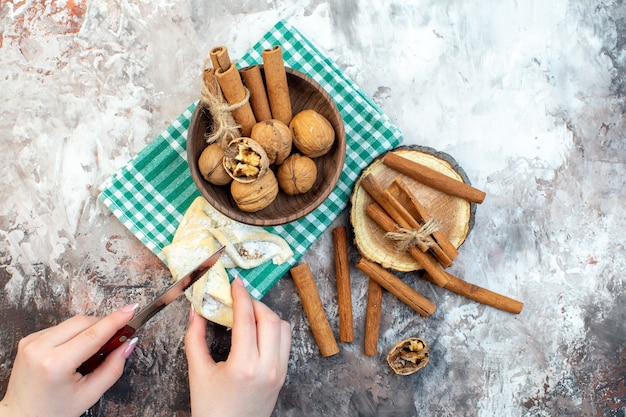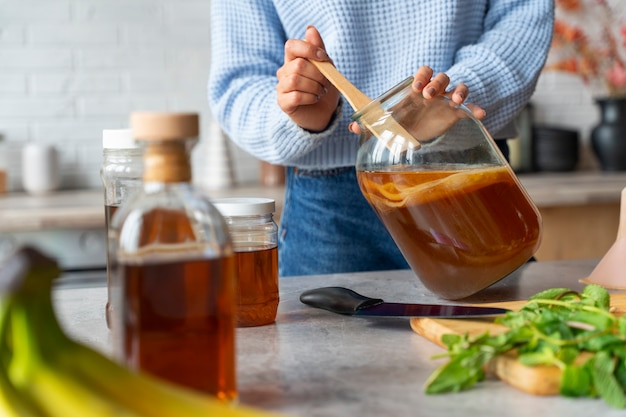Ginger. It's that magical ingredient that can transform a dish from ordinary to extraordinary. A whisper of ginger can add a warm, peppery kick, a subtle sweetness, or a refreshing zing – it all depends on how you use it. But, sometimes, you just need a little guidance, right? You’re not sure how much to use, what type of ginger is best, or even what dishes it'll really work well in. Fear not, my fellow foodie! Today, we're diving into the fascinating world of ginger, and I’m here to share all the tricks and tips I've learned over the years for using it to create truly delicious meals.
(Part 1) From Humble Root to Culinary Star

Let's start with the basics, shall we? It's always a good idea to get to know your ingredients, and ginger is no exception. Have you ever stopped to really think about what ginger is? It’s a rhizome, which is a horizontal underground stem. So, the part we use for cooking is actually the root! And it’s a surprisingly fascinating one, steeped in history and intrigue.
A Bit of History: A Spice More Precious Than Gold
Ginger has been used for centuries, both in traditional medicine and cooking. It originated in Southeast Asia, and believe it or not, it was once considered more valuable than gold! Its journey across the globe is a captivating story of trade routes, cultural exchange, and the enduring power of this humble root. Imagine that – ginger was once a treasure!
Types of Ginger: Exploring the Spectrum of Flavor
You might think all ginger is the same, but there are actually a few different types you’ll find in supermarkets or at your local market. Here's a quick rundown:
- Young Ginger: This is the tender, pale ginger you’ll often find in Asian markets. It has a milder flavor and a more delicate texture than mature ginger. You can use it in stir-fries, salads, and even eat it raw for a fresh, slightly spicy bite.
- Mature Ginger: This is the more common type, with its knobby, brown skin. It boasts a stronger, more pungent flavor and is the perfect choice for curries, soups, and marinades. It's the ginger you're most likely to find in your local grocery store.
- Preserved Ginger: This is ginger that has been preserved in sugar, often coming in a jar. It has a sweet, slightly tart flavor and is commonly used in desserts and as a topping for cocktails. The sweetness of preserved ginger can be a delightful surprise in dishes where you'd least expect it!
(Part 2) The Ginger Prep: Unlocking the Flavor

Alright, so you’ve got your ginger – but now what? It's time to get into the nitty-gritty of preparing it. You might be thinking, "It's just ginger, how hard can it be?" But trust me, proper prep can make a world of difference in the final flavor.
Peeling and Chopping: Precision for Flavor
You’ll want to use a sharp paring knife to peel off the ginger's tough outer skin. Don't worry about being perfect; a little bit of the skin won't hurt the flavor. Once peeled, you can chop it into small pieces, grate it, or mince it. If you're using ginger in a stir-fry, you'll often want to slice it thinly or even julienne it for a lovely visual appeal and even cooking. For marinades or sauces, finely grated ginger is usually the best choice to release all those flavorful compounds.
Ginger Paste: Your Kitchen Shortcut
Ginger paste is a true lifesaver in the kitchen. It's pre-minced ginger that's been blended into a smooth paste, making it incredibly convenient. You can find it readily available at most supermarkets. It's perfect for when you need a quick and easy way to add ginger flavor to your dish, especially when you're short on time.
(Part 3) Ginger's Versatility: A Flavor for Every Occasion

So, you're probably wondering what you can actually do with all this ginger, right? Don't worry, we're about to explore the amazing range of dishes where ginger shines. From savory to sweet, ginger can add a touch of magic to just about anything you cook.
Savory Sensations: Ginger's Culinary Prowess
Ginger truly comes into its own in savory dishes. It adds depth and complexity to everything from curries to soups and stir-fries. Here are a few ways to use ginger in savory cooking:
- Curries: Ginger is a staple in curries from around the world, adding a warm, spicy kick to the dish. It's typically used in combination with other aromatics like garlic, onions, and chilies, creating a symphony of flavor.
- Stir-fries: Ginger adds a wonderful flavor and aroma to stir-fries, complementing the other vegetables and meat beautifully. It's often used with soy sauce, garlic, and chili to create a flavorful sauce that coats the ingredients perfectly.
- Soups: Ginger can add a comforting warmth to soups. It's particularly good in chicken noodle soup, vegetable soup, and tomato soup. Try adding a sliver or two of ginger to your next pot of soup and see how it elevates the flavor. You'll be surprised at how much depth it adds!
- Marinades: Ginger is a fantastic ingredient in marinades for meat, poultry, and fish. It tenderizes the meat and adds a complex flavor profile that will have everyone asking for seconds.
Sweet Surprises: Ginger's Unexpected Side
Don't be fooled, ginger isn't just for savory dishes! It can add a unique twist to sweet treats as well. Here are a few ideas:
- Gingerbread: Ginger is a classic ingredient in gingerbread, adding a warm, spicy flavor to this beloved holiday treat.
- Ginger Snaps: These crunchy, spicy cookies are a perfect companion to a cup of tea or coffee. They get their distinctive flavor from the ginger, which is often combined with cinnamon and molasses, creating a delightful contrast of flavors.
- Ginger Drinks: Ginger can be added to drinks, both hot and cold. Ginger ale is a classic example, but you can also make your own ginger tea or even add ginger to smoothies and cocktails for a refreshing kick.
(Part 4) Ginger's Health Benefits: More Than Just Flavor
You know what they say, "food is medicine!" and ginger is no exception. It's been used for centuries in traditional medicine and it's packed with health benefits. So, not only does it add incredible flavor to your meals, but it's also good for you.
Aids in Digestion: Soothes Your Stomach
Ginger has been used for centuries to soothe nausea and upset stomach. It's thought to help stimulate digestion and reduce bloating and gas. So, if you're feeling a little under the weather, a cup of ginger tea might be just what you need.
May Reduce Inflammation: A Natural Anti-Inflammatory
Ginger contains compounds that have anti-inflammatory properties, which may help reduce muscle soreness and joint pain. A little ginger can go a long way in easing discomfort and promoting overall wellbeing.
Boosts Immunity: A Natural Defense Booster
Ginger is a good source of antioxidants, which can help protect your body against damage from free radicals and boost your immune system. It's a little powerhouse of natural goodness, helping to keep you feeling healthy and strong.
Other Potential Benefits: A Multifaceted Remedy
Research is ongoing, but some studies suggest that ginger may also have benefits for blood sugar control, heart health, and brain function. While more research is needed, it's certainly an ingredient worth incorporating into your diet for its potential health benefits.
(Part 5) Ginger Storage: Keeping Your Ginger Fresh
You've got your ginger, you've prepped it, and you're ready to cook! But how do you keep that ginger fresh and flavorful for as long as possible? Don't worry, there are a few simple tips to help you store ginger properly and avoid those sad, dried-out pieces in the back of your crisper drawer.
In the Fridge: Keeping It Crisp
The best way to store ginger is in the refrigerator. You can wrap it in plastic wrap or put it in a zip-top bag. It should last for several weeks in the fridge, ready for your next culinary adventure.
Freezing for the Long Haul: Preserving Flavor
If you want to store your ginger for even longer, you can freeze it. Simply peel and grate the ginger, then transfer it to an airtight container or freezer bag. Frozen ginger can last for several months. This is a great option for when you buy a large piece of ginger and don't plan on using it all right away.
For Longer Storage: A Simple Trick
If you've got a whole piece of ginger and want to store it longer than a few weeks, try this simple trick: wrap the ginger in paper towels, then place it in an airtight container. This will help absorb moisture and prevent the ginger from drying out. It's a simple technique that can make a big difference in preserving the freshness of your ginger.
(Part 6) Ginger and Spice: A Flavorful Union
We've covered the basics of ginger, its prep, and its versatility. But the magic of ginger truly comes alive when it's combined with other spices. Think of ginger as the conductor of a culinary orchestra, bringing all the other flavors together in perfect harmony.
Classic Combinations: Harmonizing Flavors
Here are a few classic pairings that you'll see time and time again in recipes:
- Ginger and Garlic: This dynamic duo is a cornerstone of Asian cuisine. The pungent garlic balances out the warmth of the ginger, creating a flavor combination that's simply irresistible. They complement each other beautifully, creating a flavor profile that is both bold and aromatic.
- Ginger and Chili: The heat of chili and the warmth of ginger complement each other perfectly. This combination is found in many Asian and Caribbean dishes, adding a fiery kick to the food. The chili adds a punch of heat, while the ginger provides a warm and comforting note.
- Ginger and Cinnamon: This pairing is perfect for baked goods like gingerbread and ginger snaps. The sweetness of the cinnamon and the warmth of the ginger create a cozy and comforting flavor. It's a classic combination for a reason – it’s simply irresistible!
- Ginger and Turmeric: Both ginger and turmeric have anti-inflammatory properties, making this a healthy and flavorful combination. It's often used in curries and other Indian dishes, adding a vibrant golden hue and a warm, earthy flavor.
- Ginger and Black Pepper: The peppery notes of black pepper enhance the warmth of the ginger, creating a savory and complex flavor. This combination is often used in stir-fries and marinades, adding a touch of spice and sophistication.
Experiment with Flavor: Let Your Creativity Shine
Don't be afraid to experiment with different combinations of spices and see what you come up with! You might be surprised by the delicious flavors you create. Playing with different spices can lead to unexpected and delightful culinary discoveries.
(Part 7) From Kitchen to Cocktail: Ginger's Versatile Appeal
Ginger isn't just for cooking, you know! It's also a popular ingredient in cocktails and beverages. From classic ginger ale to the latest trendy concoctions, ginger adds a unique kick to your drinks.
Ginger Ale: A Refreshing Classic
Ginger ale is a refreshing and slightly spicy drink that's perfect for settling an upset stomach or simply enjoying on a hot day. It's a classic for a reason – it's light, bubbly, and has a subtle ginger flavor that's both refreshing and soothing.
Ginger Beer: A More Intense Flavor
Ginger beer is similar to ginger ale but has a stronger, more intense ginger flavor. It's often used in cocktails like the Moscow Mule. The sharper ginger flavor adds a kick to the cocktail, making it more complex and interesting.
Ginger Tea: Warm and Comforting
Ginger tea is a warm and comforting drink that can help soothe a sore throat and reduce nausea. You can make it by steeping fresh ginger in hot water or using pre-made ginger tea bags. It's a simple yet effective remedy for a range of ailments.
Ginger Cocktails: Trendy and Delicious
Ginger is a popular ingredient in cocktails, adding a unique twist to classic drinks. The Moscow Mule, a combination of vodka, ginger beer, and lime juice, is a classic example. You can also add ginger to margaritas, daiquiris, and even mojitos for a refreshing twist. Ginger adds a complexity and depth to cocktails, making them more flavorful and interesting.
(Part 8) Top Ginger Recipes: Flavorful Inspiration
Alright, so you've got a handle on ginger's versatility, you know what it pairs well with, and you're ready to start cooking! But you might be thinking, "Where do I even begin?" Fear not, here are a few of my favorite ginger recipes that are sure to tantalize your taste buds.
Stir-Fried Ginger Chicken: A Classic with a Zing
This dish is a classic for a reason! The ginger adds a warm, spicy kick that complements the tender chicken and crisp vegetables perfectly. It's a simple dish to make, yet it's packed with flavor. It's a crowd-pleaser that's sure to leave everyone wanting more.
Gingerbread Cookies: A Festive Delight
These cookies are a holiday staple, but they're delicious any time of year. The ginger adds a warm, spicy flavor that's both comforting and festive. They're a classic for a reason – they're simply irresistible!
Ginger-Glazed Salmon: A Sweet and Savory Masterpiece
This recipe is a true crowd-pleaser. The ginger glaze adds a sweet and savory flavor to the salmon, while the fish remains moist and tender. It's a simple yet elegant dish that's perfect for a special occasion or a weeknight dinner.
Ginger Tea: A Simple and Effective Remedy
This is a simple yet effective recipe for a warm and comforting ginger tea. It's perfect for soothing a sore throat or simply enjoying on a chilly day. It's a classic for a reason – it's soothing, refreshing, and packed with flavor.
Spicy Ginger Noodles: A Flavorful Adventure
These noodles are packed with flavor and texture! The ginger adds a warm, spicy kick, while the vegetables and sauce provide a delicious balance. It's a quick and easy meal that's bursting with flavor.
(Part 9) FAQs: Unveiling the Secrets of Ginger
You've made it this far! You're now a ginger pro, but maybe you still have a few lingering questions. Here are some common FAQs about using ginger in cooking, and I'm here to help you find the answers!
FAQs
| Question | Answer |
|---|---|
| What does ginger taste like? | Ginger has a complex flavor that's both warm and spicy. It can be slightly sweet or peppery depending on how it's used and what other flavors it's combined with. Think of it as a mix of warmth, spice, and a hint of sweetness, all rolled into one. |
| How much ginger should I use? | It really depends on the dish and your personal preference. Start with a small amount, about 1 teaspoon of grated ginger, and add more to taste. Remember, you can always add more, but you can't take it away! |
| What happens if I use too much ginger? | If you use too much ginger, your dish will have an overwhelming, pungent flavor. You can try to dilute the ginger flavor by adding more liquid or other ingredients, but it's best to err on the side of caution and use a small amount at first. |
| Can I use fresh ginger instead of ginger paste? | Yes, you can absolutely use fresh ginger instead of ginger paste! Just make sure to mince or grate it finely to release its flavor. |
| Can I use ground ginger instead of fresh? | Ground ginger is less potent than fresh ginger, so you'll need to use a larger amount to achieve a similar flavor. Fresh ginger is typically preferred, but if you're in a pinch, ground ginger will work. |
There you have it! That's my comprehensive guide to cooking with ginger. Go forth and experiment, unleash your culinary creativity, and enjoy the amazing flavor that ginger brings to your dishes. I'm confident that you'll be a ginger-loving master chef in no time. Happy cooking!
Everyone is watching

Corn on the Cob: The Ultimate Guide to Perfectly Cooked Ears
Healthy MealsAh, corn on the cob. Just the name evokes images of sunny days, barbecues, and that sweet, juicy flavour that ...

Perfect Pork Roast Oven Cooking Time: A Guide to Delicious Results
Healthy MealsThere's something truly satisfying about a perfectly roasted pork. The aroma alone is enough to make your mout...

Ham Cooking Time: How Long to Bake, Smoke, or Boil a Delicious Ham
Healthy MealsAh, ham. It's a classic, isn't it? A real crowd-pleaser, especially around holidays. And when done right, it'...

Scallops: The Ultimate Guide to Perfect Cooking
Healthy MealsAh, scallops. Those delicate, sweet, and utterly delicious morsels of the sea. They hold a special place in my...

Spaghetti Squash: The Ultimate Guide to Cooking and Serving
Healthy MealsRemember that time you saw spaghetti squash at the supermarket, looking all bumpy and strange, and thought, "W...
